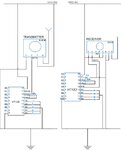salvazero
Newbie level 4
I want design this project for magic shows, and I would like to include this in the act.
How Can I design a circuit so I can make the ball move? I need to design circuit for it.
The wand will have the transmitter.
The ball will have the receiver in it.
I want to make it stop when the wand is less than 1 feet away and or plus 2+ feet away.
Start at 1-2 feet, spacing is not critical. Close is good enough. Parts I think I need.
The Wand
1. An adjustable transmitter
2. Battery The ball
1. A receiver
2. Motor-do not include in your circuit
3. Battery
4. Gears- do not include in your circuit
I need for you to advise me on what is the best way to make this magic toy. I just need the circuit without the motor or gears.
See the example

This is an example only
I need a correct circuit for it.
1. I need a transmitter to transmitter only at a distant of 1-2 feet only. I was told that I would need an adjustable transmitter and Receiver.
2. I will be removing the on and off switch in the ball and replacing it with the receiver, to tell it to come on or off. The receiver will open and close the circuit for the battery to activate the switch.
Can you supply me a schematic showing me the wires to connect and what type of transmitter and Receiver to buy and any other components that I might need to complete the circuit?
I want to know Schematic showing me the wires to connect and Parts I will need.

Any help will be appreciated.
Thanks in advance
How Can I design a circuit so I can make the ball move? I need to design circuit for it.
The wand will have the transmitter.
The ball will have the receiver in it.
I want to make it stop when the wand is less than 1 feet away and or plus 2+ feet away.
Start at 1-2 feet, spacing is not critical. Close is good enough. Parts I think I need.
The Wand
1. An adjustable transmitter
2. Battery The ball
1. A receiver
2. Motor-do not include in your circuit
3. Battery
4. Gears- do not include in your circuit
I need for you to advise me on what is the best way to make this magic toy. I just need the circuit without the motor or gears.
See the example

This is an example only
I need a correct circuit for it.
1. I need a transmitter to transmitter only at a distant of 1-2 feet only. I was told that I would need an adjustable transmitter and Receiver.
2. I will be removing the on and off switch in the ball and replacing it with the receiver, to tell it to come on or off. The receiver will open and close the circuit for the battery to activate the switch.
Can you supply me a schematic showing me the wires to connect and what type of transmitter and Receiver to buy and any other components that I might need to complete the circuit?
I want to know Schematic showing me the wires to connect and Parts I will need.

Any help will be appreciated.
Thanks in advance